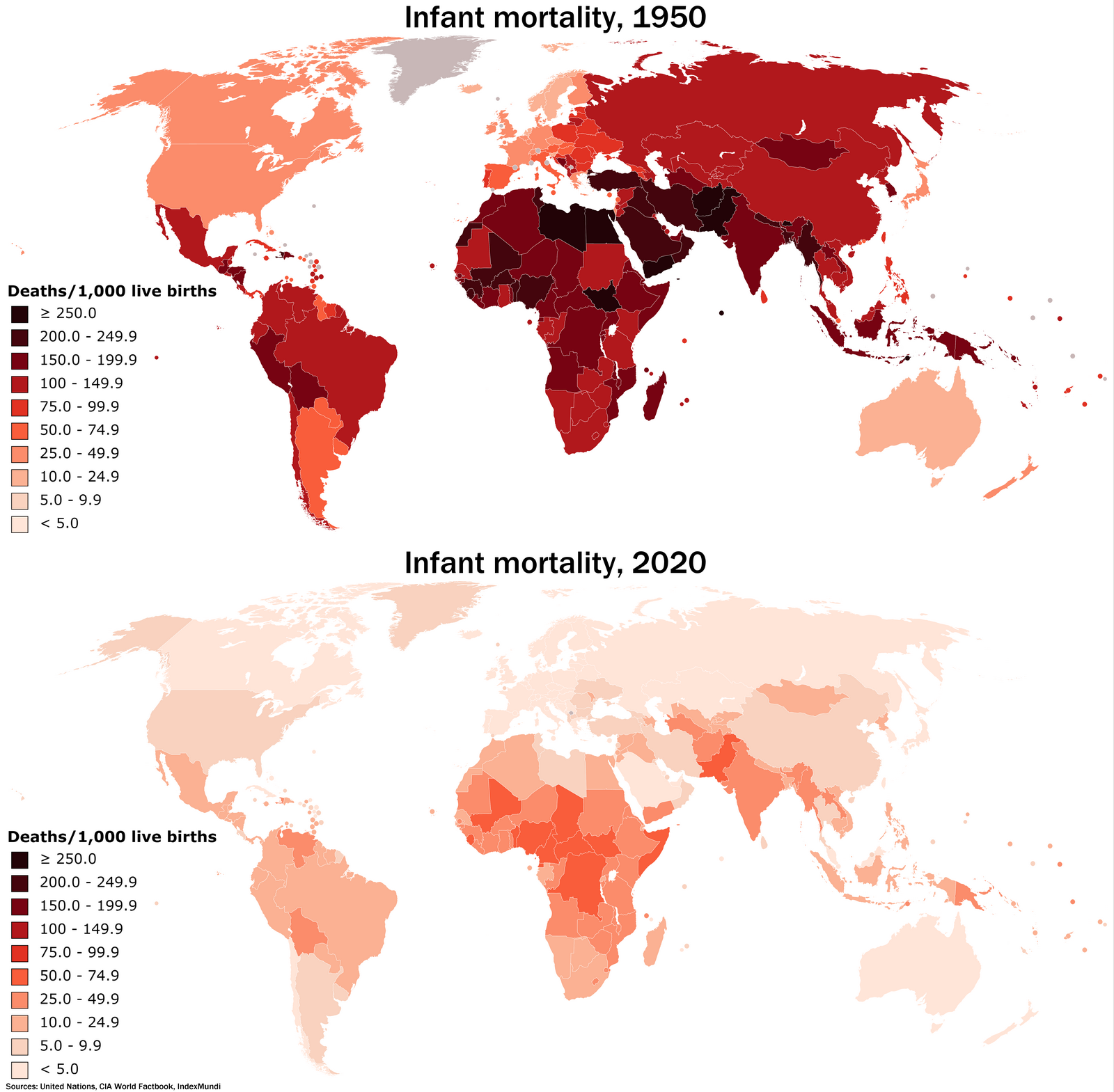Infant mortality rates represent a critical public health issue, particularly when viewed through the lens of racial disparities. A recent study revealed that Black infants die at nearly twice the rate of their white counterparts, underlining alarming mortality disparities that have persisted for decades. Despite an overall improvement in life expectancy for all racial groups, the gap in infant mortality rates has only widened, raising concerns about healthcare inequality. This tragic reality calls for urgent attention from policymakers and health organizations to address the underlying factors contributing to these differences. Understanding the causes and implications of these statistics is vital to creating equitable health solutions that ensure all infants receive the care they deserve.
The topic of infant death rates highlights significant concerns about child health across different demographics. Recent findings show that the mortality figures among young children differ dramatically between racial groups, indicating substantial inequities in health outcomes. While life expectancy has improved across the board, marginalized groups, particularly within the Black community, continue to face higher rates of infant loss. This calls into question the quality and accessibility of healthcare services provided to these populations. It is essential to investigate these alarming trends to prioritize interventions that could bridge the gap and promote healthier futures for all children.
Examining Infant Mortality Rates in America
In recent years, the focus on infant mortality rates has highlighted stark disparities between racial groups in the United States. Current data reveals that Black infants die at an alarming rate of twice that of white infants, a gap that has only widened since the 1950s. This troubling trend emphasizes the urgent need for interventions aimed at addressing healthcare inequality. While both groups have seen improvements in life expectancy, these figures mask the underlying issues contributing to mortality disparities among infants. As policymakers and healthcare providers grapple with these statistics, the persistence of such a gap evokes urgent discussions on race-specific healthcare strategies.
The widening chasm in infant mortality rates is indicative of deeper systemic issues within the healthcare system. Factors such as access to prenatal care, socioeconomic status, and the overarching impact of stressors related to racial discrimination play pivotal roles in these disparities. Medical conditions during pregnancy, which have historically led to higher mortality rates in Black infants, require targeted solutions that address not just the immediate health needs but also the social determinants of health. A comprehensive approach involving community support and enhanced healthcare resources is essential to close this critical gap.
The Impact of Healthcare Inequality on Racial Disparities
Healthcare inequality remains a pressing issue in the U.S., particularly as it relates to infant mortality rates. The study by researchers, including Soroush Saghafian, highlights how Black infants face significantly higher mortality rates compared to white infants, a reality that has persisted through decades. Healthcare inequality encompasses not only differences in access but also the quality of care received by different racial groups. For instance, factors such as location, insurance coverage, and healthcare provider bias contribute to a healthcare environment where marginalized communities often receive substandard care.
Addressing healthcare inequality is vital to reducing the mortality disparities observed in infants. Policymakers must acknowledge the multifaceted nature of these disparities, which include economic, educational, and social barriers that hinder access to adequate healthcare. Efforts to improve healthcare delivery must focus on equitable access to prenatal and postnatal care for all racial groups. By implementing policies that ensure quality health services for disadvantaged communities, the aim should be to bridge the mortality gap effectively and improve overall health outcomes for all infants.
Racial Disparities in Life Expectancy
While the overall life expectancy for Americans has seen significant improvement, the racial disparities in healthcare cannot be overlooked. The current research indicates that Black Americans have a higher mortality rate than their white counterparts, which directly affects life expectancy figures. In the past 70 years, the life expectancy for Black Americans increased substantially, yet the persistent inequality in healthcare access and treatment underscores a crucial area for improvement. Focusing on these disparities provides valuable insight into how systemic issues impact the longevity of different racial groups.
To fully understand life expectancy gaps, it is essential to consider the broader context of health inequities faced by Black Americans. Discrimination within healthcare settings, coupled with a lack of investment in community health resources, contributes to the ongoing challenges. As life expectancy trends improve, it becomes increasingly vital for health officials to analyze the roots of these disparities. Without targeted policies aimed at equity in health services, the progress made in increasing life expectancy may not benefit all groups equally.
Long-term Trends in Mortality Rates
Analyzing long-term trends in mortality rates reveals critical insights into the effectiveness of healthcare approaches over the decades. The comprehensive study conducted by researchers spanning 70 years illuminates the changing dynamics of mortality rates between Black and white Americans. Understanding these trends helps to paint a clearer picture of the health landscape and reinforces the need for ongoing research that examines health outcomes over extended periods. Such studies highlight the importance of historical context in understanding current health challenges.
Longitudinal analyses will aid in the identification of persistent issues contributing to racial disparities in mortality. The broader context of these findings demonstrates that while general healthcare metrics may show improvement, they do not reflect the specific experiences of marginalized populations. Focusing on long-term trends allows researchers to pinpoint when and where inequalities emerged and how they have evolved. By acknowledging past shortcomings and successes, public health strategies can be better formulated to address existing gaps and prevent future disparities.
Future Directions for Public Health Policy
The alarming findings regarding infant mortality rates and healthcare inequality necessitate a reevaluation of public health policies. As identified through extensive research, disparities in mortality rates indicate that systemic barriers must be dismantled to promote equity in healthcare services. Policymakers are called to take immediate action to rectify these inequities, ensuring better access to health resources, particularly for Black communities. Prioritizing public health interventions that specifically address the unique needs of diverse populations can foster improved health outcomes and reduce infant mortality rates.
Public health initiatives must also focus on enhancing education and outreach to marginalized communities regarding available healthcare services. By raising awareness and promoting healthcare literacy, individuals can become empowered to seek necessary care, thereby improving health outcomes. This proactive approach can contribute significantly to reducing mortality disparities and fostering a more equitable healthcare system. It is imperative to commit to these strategies to prevent unnecessary loss of life and to ultimately achieve better health metrics across racial lines.
The Role of Community Health Initiatives
Community health initiatives play a crucial role in mitigating disparities in infant mortality rates. By fostering a supportive environment that promotes maternal and infant health, these programs can help bridge the gap caused by healthcare inequality. Community-based interventions provide essential resources, education, and services tailored to the needs of local populations. These initiatives empower families and encourage healthy practices that can significantly reduce the risks associated with infant mortality.
Moreover, collaboration between healthcare providers and community organizations is vital in addressing the social determinants of health that contribute to mortality disparities. Programs focusing on prenatal care access, nutrition, and mental health support can create a comprehensive network of care that directly impacts the well-being of mothers and infants. Investing in community health initiatives not only addresses immediate healthcare needs but also fosters long-term relationships that promote overall health equity.
Understanding the Impact of Social Determinants of Health
Social determinants of health are critical factors influencing the health outcomes of different racial groups, particularly in the context of infant mortality. Research indicates that socioeconomic status, education, environment, and access to healthcare services all play significant roles in shaping health outcomes. Addressing these social determinants is essential to making strides toward reducing the disparities faced by Black infants. By understanding how these factors interact, public health officials can develop targeted strategies to mitigate their impacts.
Investing in education and economic empowerment for Black communities can lead to healthier lifestyles and improved healthcare access. Working towards ensuring that every individual has the resources and support necessary for optimal health outcomes will help lessen the staggering disparities in infant mortality rates. As society confronts these challenges, a commitment to equity in healthcare and addressing social determinants must remain a priority in the pursuit of a healthier future for all children.
Engaging Stakeholders in Health Equity Conversations
Engaging a wide range of stakeholders in discussions about health equity is essential to drive systemic change. Bringing together healthcare professionals, policymakers, community leaders, and affected families can provide multiple perspectives on the issues surrounding infant mortality and healthcare inequality. Cultivating these dialogues can lead to collaborative solutions that address the root causes of disparities and promote better health outcomes for all racial groups, particularly for vulnerable populations.
These conversations can also empower communities to advocate for themselves, fostering greater awareness and understanding of the systemic barriers they face. Engaging stakeholders helps to amplify voices that often remain unheard in health policymaking, ensuring that diverse experiences and insights shape the conversation around infant mortality and healthcare. By working together, stakeholders can develop actionable plans to tackle healthcare inequalities and enhance the overall well-being of affected communities.
The Need for Data-Driven Solutions
To effectively combat the disparities in infant mortality rates, a data-driven approach is crucial. The comprehensive analysis conducted over seven decades has provided a wealth of information highlighting the manifold issues that contribute to these disparities. Data allows researchers and policymakers to identify patterns, track progress and tailor interventions that address the unique needs of affected communities. By basing decisions on empirical evidence, stakeholders can ensure resources are allocated effectively to areas where they are most needed.
Furthermore, continuous monitoring of healthcare outcomes is vital to evaluate the success of implemented strategies. By leveraging data, public health officials can adapt approaches in real time, ensuring that efforts remain relevant and impactful. This commitment to data-driven solutions can pave the way toward reducing infant mortality rates and establishing a more equitable healthcare system for all.
Frequently Asked Questions
How do infant mortality rates compare between Black infants and white infants in the U.S.?
Infant mortality rates in the U.S. show that Black infants are dying at rates more than twice that of white infants. A recent study indicated that the disparity in mortality rates has widened, with Black infants experiencing a 115 percent higher mortality rate than white infants, compared to a 92 percent difference in the 1950s.
What factors contribute to the disparities in infant mortality rates between different racial groups?
The disparities in infant mortality rates, particularly between Black and white infants, are largely attributed to healthcare inequality. Access to quality medical care, socio-economic factors, and specific medical conditions during pregnancy are primary contributors to the excess mortality rates among Black infants compared to their white counterparts.
What has changed in life expectancy over the last 70 years for Black and white Americans?
While life expectancy has improved for both Black and white Americans over the past 70 years, the gap in overall mortality rates has narrowed. However, this progress does not extend to infant mortality rates, where Black infants still face substantial disparities compared to white infants.
Why is it vital to address infant mortality rates within the context of healthcare inequality?
Addressing infant mortality rates is essential because they reflect broader issues of healthcare inequality and systemic disparities that affect Black Americans. As indicated by research, closing the gaps in these rates could have prevented millions of excess deaths if Black Americans had received the same healthcare resources as white Americans.
What implications do current infant mortality rates have for public health policy?
Current infant mortality rates highlight the urgent need for targeted public health policies to address healthcare inequality. The high mortality rates among Black infants signal that more resources and focused initiatives are required to ensure equitable healthcare access and improve maternal and infant health outcomes across racial lines.
What are the potential consequences of not addressing the differences in infant mortality rates?
Failure to address the disparities in infant mortality rates can have significant consequences, including ongoing loss of life, perpetuation of healthcare inequalities, and continued socio-economic disadvantages for affected communities. This inequity can further entrench systemic health disparities that affect future generations.
| Category | Findings |
|---|---|
| Overall Mortality Rates | Narrowed gap between Black and white Americans since the 1950s. |
| Infant Mortality Rates | Black infants die at twice the rate of white infants, a worsening disparity from previous decades. |
| Life Expectancy Growth | Black Americans: 60.5 years in the 1950s to 76 years in the 2010s. White Americans: 69 years in the 1950s to 79.3 years in the 2010s. |
| Health Disparities | An 18 percent higher mortality rate for Black adults compared to white adults. |
| Infant Mortality Causes | Main reasons for excess deaths include medical conditions during pregnancy and healthcare inequalities. |
| Potential Lives Saved | 5 million excess deaths of Black Americans could have been prevented with equal resources. |
Summary
Infant mortality rates in America present a troubling picture, with Black infants facing a mortality rate that is twice as high as that of white infants. Despite improvements in overall life expectancy for both racial groups over the past 70 years, the disparities among infants have not only persisted but have actually widened. This alarming trend raises significant concerns about healthcare accessibility and quality, highlighting an urgent need for policy interventions to address these inequities. As the research indicates, if the same resources that white Americans have access to were made available to Black Americans, an estimated 5 million lives could have been saved. The analysis underscores the critical importance of addressing disparities in infant mortality rates to ensure equitable health outcomes for all.







